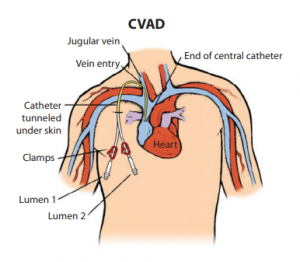A Central Venous Access Device (CVAD) is a medical device used to provide central venous access in a healthcare setting. Central venous access refers to the process of inserting a catheter into the body to deliver medications, fluids, blood products, and other therapeutic substances, while also allowing for the monitoring of pressure and blood flow within the body. CVADs are typically inserted by physicians or nurses in appropriate settings such as operating rooms or clinics.
CVADs are used when long-term or frequent access to the central venous system is required. The central venous system consists of large veins that lead directly to the heart, such as the superior vena cava, inferior vena cava, and subclavian veins. These veins provide a direct pathway for the delivery of medications and fluids, especially when peripheral veins may be difficult to access or inadequate for the required treatments.
There are different types of CVADs available, each with its own characteristics and indications for use. The most commonly used CVADs include:
- Central Venous Catheters (CVCs): These are flexible catheters inserted into a large vein, usually in the neck, chest, or groin area. CVCs can be single- or multi-lumen and may have various designs, such as tunneled or non-tunneled. They are used for a wide range of purposes, including chemotherapy administration, parenteral nutrition, and long-term medication delivery.
- Peripherally Inserted Central Catheters (PICCs): PICCs are long catheters that are inserted into a peripheral vein, usually in the arm, and advanced until the tip reaches a central vein. They are then secured in place and can remain in the body for an extended period. PICCs are commonly used for prolonged antibiotic therapy, chemotherapy, and intravenous therapies that require long-term access.
- Implantable Ports: These are small devices placed beneath the skin, typically in the chest area, with a catheter that is connected to a central vein. Implantable ports are accessed using a needle through the skin, allowing for repeated access to the central venous system. They are often used in patients requiring frequent or long-term intravenous treatments, such as chemotherapy or long-term antibiotic therapy.
CVAD insertion is typically performed under sterile conditions using local anesthesia. The choice of CVAD depends on various factors, including the patient’s medical condition, the duration of therapy, and the type of substances to be delivered. Once the CVAD is in place, it is crucial to maintain proper care and hygiene to minimize the risk of complications, such as infection, thrombosis (blood clot formation), and mechanical problems.
In conclusion, a Central Venous Access Device (CVAD) is a medical device used to access the central venous system for the delivery of medications, fluids, and other therapeutic substances. CVADs play a crucial role in providing long-term or frequent access when peripheral veins are not suitable. They are available in different types and are inserted by healthcare professionals in sterile conditions. Proper care and maintenance of CVADs are essential to ensure their effectiveness and minimize complications.



